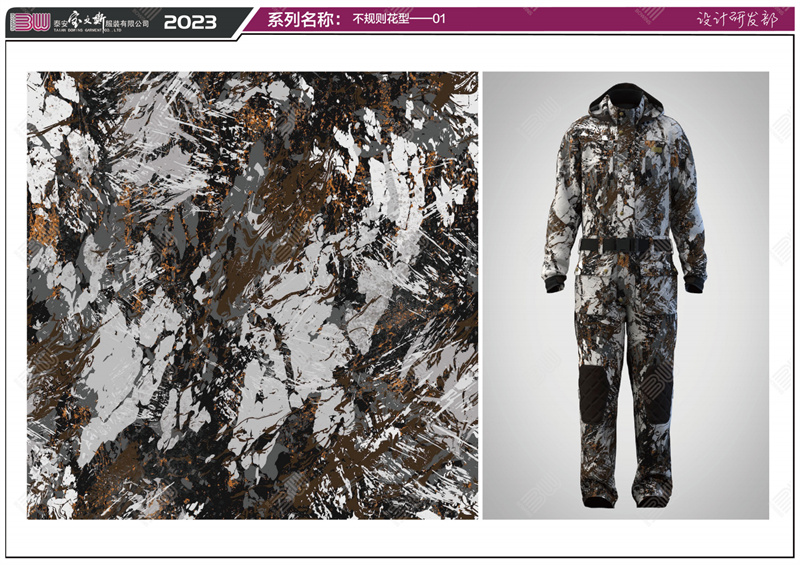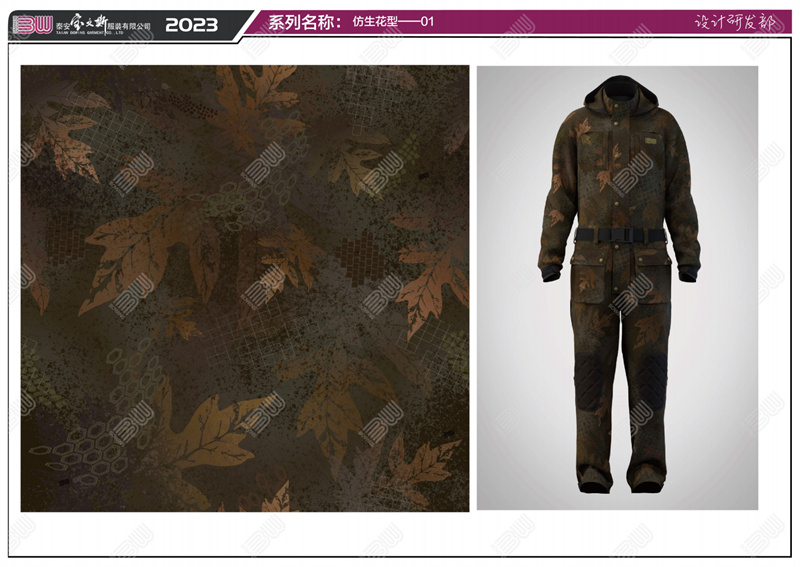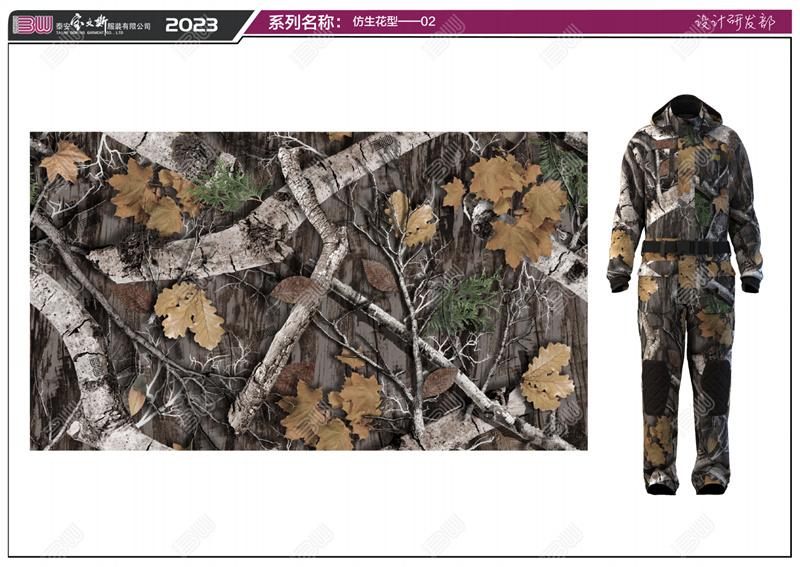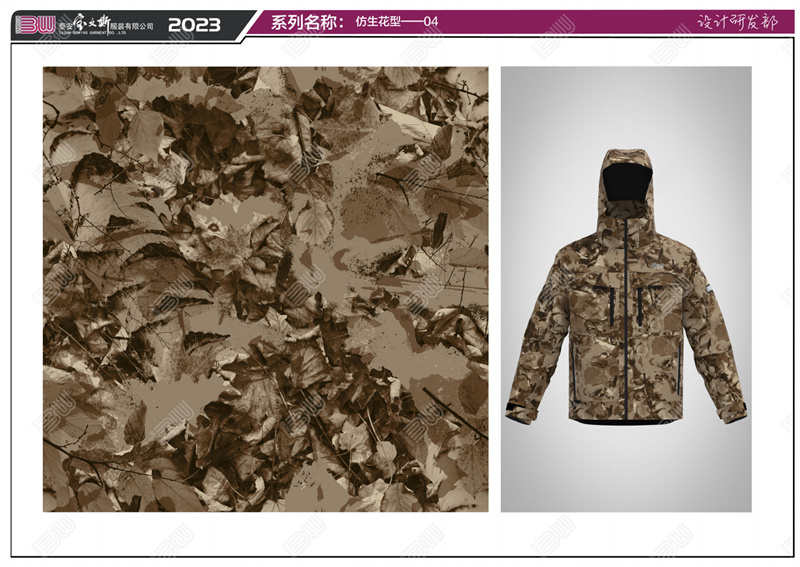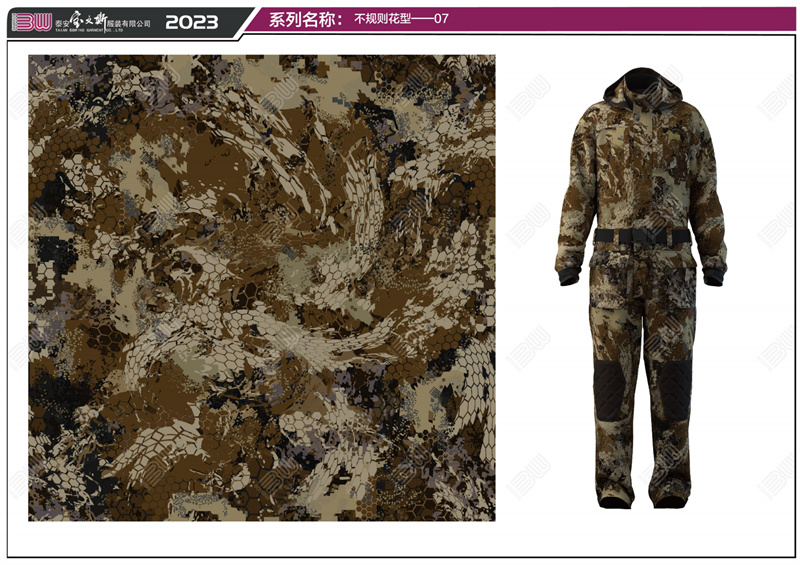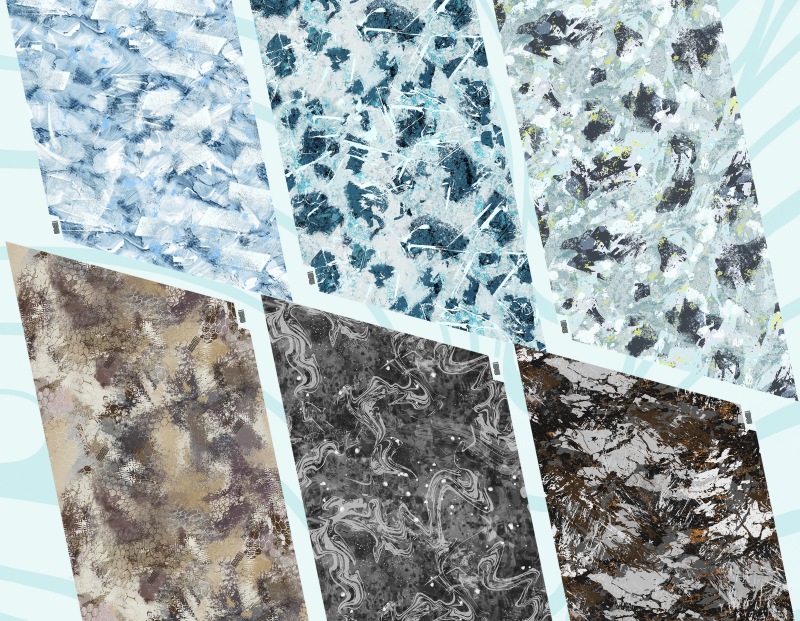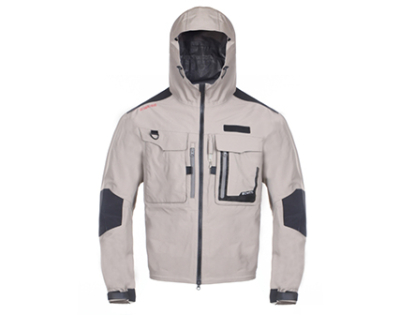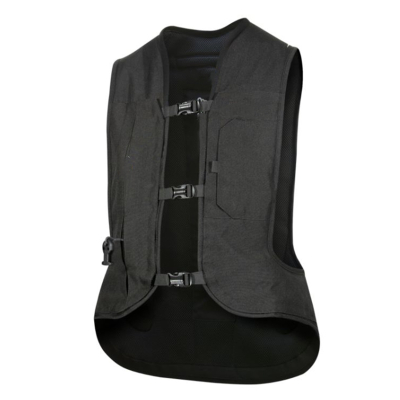Custom Hunting Clothes Camouflage Pattern Introduction
Bowins Garment is a manufacturer specializing in customized high-quality garments for our customers. Over the past 17 years, we have persistently pursued excellence, established two of our own factories, and gradually built up a good reputation and brand image in the industry through continuous growth and valuable experience. We regularly go to foreign exhibitions and visit our customers every year to maintain a long-lasting relationship between us and our customers, and our longest partnership has lasted for 17 years, and we have won the trust of more and more customers with our high-quality products and optimal service!
We understand that the needs of our customers are constantly changing, so we are committed to continuously improve our own capabilities to meet the diverse needs of different customers. From the initial original OEM, we gradually shifted to the role of ODM. This shift is our positive response to market changes, and to provide more diversified and innovative services to our customers.
In order to realize this shift, we have established a high-quality design team with rich industry experience and unique creativity. The team is dedicated to tracking fashion trends, researching market needs and translating them into unique design concepts. Our design team has a wide range of professional knowledge, not only are they familiar with the characteristics of different fabrics and processes, they will also carefully select suitable camouflage patterns and pay attention to every detail. Camouflage patterns are the soul of a hunting brand, we design exclusive camouflage patterns for customers who don't have any camouflage patterns, so as to solve the design pain points for our customers.
The camouflage patterns developed by Bowins Designs are designed to provide the following benefits and features:
We use colors and textures that blend with the natural environment, allowing hunters to remain hidden in the field and increasing the proximity of prey. Secondly, we also take into account the variations of different seasons and regions to provide applicable pattern options for fishing and hunting activities according to local conditions. Most importantly, we encourage hunters to be ethical in their hunting, respecting the natural and wildlife ecosystems and ensuring the sustainability of hunting activities. Through the design of these camouflage patterns, we hope to promote a safe, responsible and sustainable hunting experience that allows hunters to enjoy the natural environment while protecting and preserving the wildlife habitat. Below are some of the main considerations we take into account when designing camouflage patterns:
Hunting Camouflage Pattern
1. Consider the environment: first of all, we should consider the specific environment where the hunting will take place. Different environments have different shades and textures, and choosing a camouflage pattern that matches the environment can provide better camouflage effects. The camouflage pattern should be designed to fit the characteristics and colors of the target environment. Different terrains, vegetation, and seasons can affect the selection of camouflage patterns. For example, the needs of different environments such as mountains, snow or desert need to be considered. If you will be hunting in forested areas, choosing a camouflage pattern with green and brown colors may be more appropriate. If you will be hunting in grasslands or open areas, choosing a camouflage pattern with greens, browns and grays may be more effective. If you are hunting in snowy areas for winter hunting, such as goose hunting , then you can't go wrong with choosing white camouflage.
The primary color of this camouflage pattern is white, with grey and black components giving the camouflage pattern a better camouflage effect in snowy or cold winter conditions. These colors blend in with the snow and ice background to provide better concealment. And the white color helps you blend in the snow and provides good camouflage. This is especially useful for hunting or watching animals like deer and moose. It works best in environments where snow falls frequently, and hunters can't seem to go wrong with camouflage during late-season hunts when temperatures are at their lowest, snow is heavy, and deer are at their most wary.
Suitable for sparsely wooded, rocky hunting locations, this pattern is the preferred choice of many hunters when hunting bighorn and mountain-dwelling sheep because it features a variety of shades of brown, black and chalky slate.It allows hunters to blend perfectly into some of the most rugged and harsh terrain.
2. Consider the season: the season is also an important factor in choosing a camouflage pattern. Depending on the season, the colors and textures of the environment will change. For example, in the spring and summer, when vegetation is usually more lush, camouflage patterns with rich and bright greens may be more appropriate. In the fall and winter, when vegetation may be dying or covered in snow, camouflage patterns with browns, grays and blacks may be more appropriate.
The sepia and maple leaf elements in this camouflage pattern make it perfect for a fall forest setting. The fall colors of the fallen leaves and soil match the tones of this camouflage pattern, providing a better camouflage effect.
While not a pattern for stalking, this camouflage can conceal hunters hidden in tree stands. It combines a variety of colors, allowing the wearer to blend in with the skyline and foliage and appear as a ghost to unsuspecting prey. This camouflage is equally effective when hunting mule deer or elk. The pixelated spots and stripes are designed for hunters shooting at long distances. This camouflage lives up to its name as the top camouflage for big game.
3. Texture and Shape: The texture and shape of the camouflage pattern should mimic that of the target environment for camouflage effect. For example, in a woodland environment, the texture and shape of leaves and branches can be used to mimic on a target. Variations in texture and shape can help break up the outline of a target, making it more difficult to recognize.
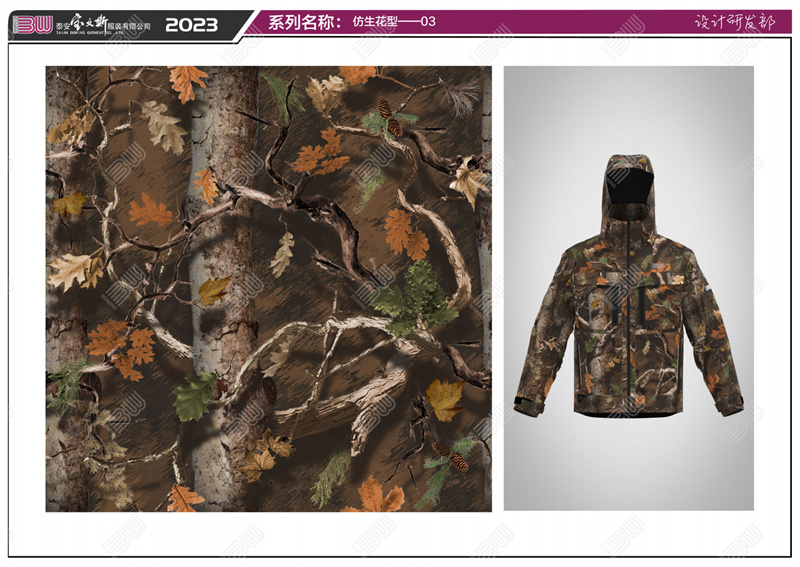
The natural tones of these two camouflage patterns and the tree trunk and maple leaf elements are great for deer hunting in a forest setting. The first model has light brown maple leaves and green vegetation accents for the early fall season, while the second model has an overall dark brown tone and maple leaf colors that give the impression of dying, making it more suitable for late fall hunting activities. Deer usually inhabit woodlands and grassland areas, and these two camouflage patterns have shades that blend with their natural habitat to provide effective camouflage.
4. Scale and resolution: camouflage pattern designs should be adapted to the scale and resolution of the target. The detail and scale of the pattern needs to be adjusted to the likely viewpoint and distance of the observer. One of the benefits of this unique pattern is that it helps to hide a moving hunter. Unlike bionic camouflage, the pattern does not use traditional bionic objects, stripes, swirls, or scales, but instead splits the upright human skeleton into twisted patches. Because of this, it is nearly impossible for animals to properly identify hunters.
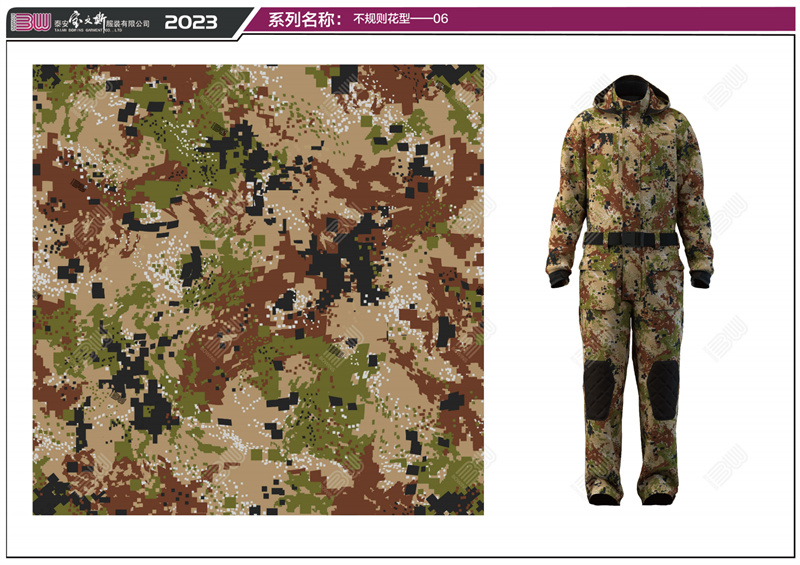
This camouflage pattern was originally designed to provide effective camouflage during hunting and outdoor activities. To the naked eye it looks like camouflage in a video game. This pixelated pattern is designed for hunters stalking in the field in heavily vegetated terrain. The pattern's earthy, gray and dark brown irregular lines and patterns help break up the wearer's silhouette, making it more difficult for enemies or prey to detect. The shades and patterns of this camouflage pattern may be suitable for hunting in dry areas or for observing animals such as hares, foxes, and deer.
5. Human perception: camouflage pattern design should also consider the way humans perceive colors and shapes. The human visual system is more sensitive to certain colors and shapes, and designers can use these characteristics to enhance the camouflage effect.
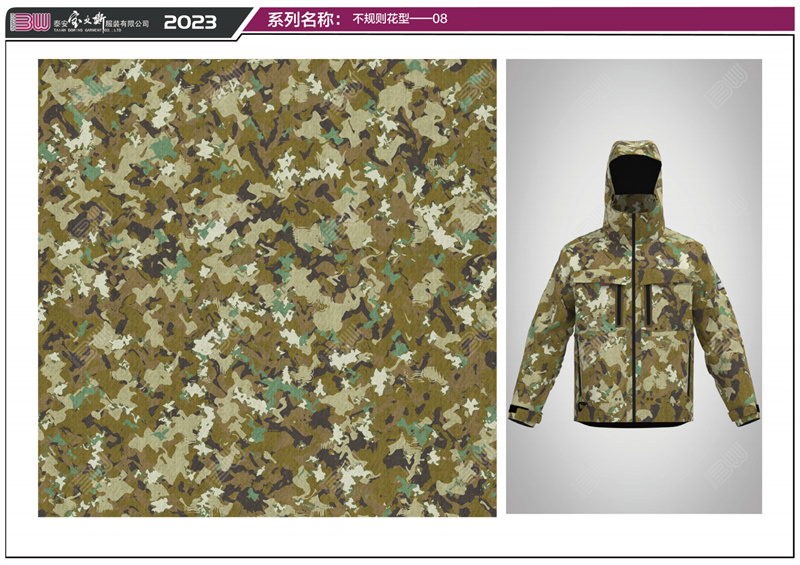
Consider the visual characteristics of the animal: Different animals perceive colors and textures in different ways. Knowing the visual characteristics of the animal you will be hunting can help you choose a more effective camouflage pattern. For example, some animals are very sensitive to red and orange colors while they are not sensitive to green and brown. Therefore, avoid choosing camouflage patterns with bright red and orange colors when hunting these sensitive animals.
6. Functional requirements: The design of camouflage patterns also needs to take into account the specific functional requirements of the target. Different tasks may require different types of camouflage patterns, for example, a hunting camouflage pattern may require a stronger camouflage effect, while a camouflage pattern for outdoor sports may focus more on fashion and comfort.
This camouflage pattern was originally designed to provide effective camouflage during hunting and outdoor activities, but it also has a certain aesthetic appeal on outdoor clothing. The irregular lines and patterns in the pattern can help break up the wearer's silhouette, making it more difficult for enemies or prey to detect. Color palette-wise, camouflage patterns that include white, yellow, gray, and sepia may be appropriate for a wide range of seasons and environments. If you frequently hunt in different places or during different seasons, it may be more practical to choose a camouflage pattern that provides good camouflage in a variety of environments.It is also a good choice in casual urban outdoor wear. to meet consumer demand for fashion and practicality.
Fishing clothes camouflage pattern:
Fishing clothes camouflage compared to hunting clothes camouflage will be slightly less variety, because the fishing environment is not as diverse and complex as the hunting environment, but the original intention of the design and considerations are the same. The main consideration of environmental compatibility, camouflage fishing clothing colors and patterns should be able to coordinate with the water environment. For fishing locations such as lakes, rivers and estuaries, camouflage patterns in blue and gray tones are more suitable in order to make the angler less visible to the fish on the water. This camouflage pattern mimics the color and texture of the water, providing better concealment. It can improve anglers' fishing and comfort in outdoor activities.
Bowins Garment, as a professional manufacturer of hunting and fishing clothing, not only focuses on the appearance and quality of the clothing, but also focuses on the practicality and fit of the clothing, understanding their brand values and target audience to ensure that the design solution is a perfect fit for the customer's needs. By continually improving our capabilities and having a highly qualified design team, we are certain that Bowins Garment will continue to be a leader in the industry, providing exceptional apparel solutions to our customers. We are committed to continue to innovate, strive for excellence and work hand in hand with our customers to achieve the goal of business success and mutual growth.








